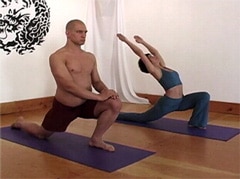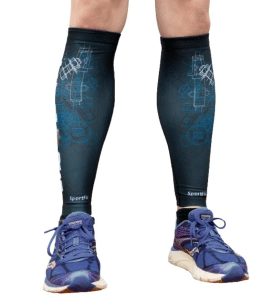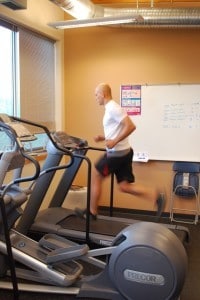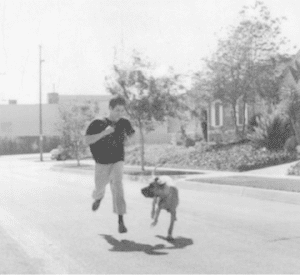I blame Bruce Lee, for it was he who first brought the fact that martial artists should run to my attention.
It was in the eighties and I came across a photo of Bruce Lee running down the road in the book Bruce Lee’s Fighting Method Vol 2. The text talked about how important he thought running was, and mentioned that, “Even when he was sent to India to find suitable locations for filming, he took along his running shoes.”
I thought, “Hmmm, if Bruce Lee thought that running was important then maybe I should take it seriously too…”
It didn’t stick. I made a few abortive attempts to add running to my training regimen, but I wasn’t any good at it and it hurt (click here for the complete I Can’t Run Excuse List), so eventually I gave up.
It was many years later that I managed to make friends with running, but as soon as I was doing it consistently the results on my jiu-jitsu were very impressive.
Once I started running regularly I simply had more endurance, which meant that I was able to outlast my opponents. I felt stronger for longer. And – interestingly enough – I felt mentally sharper and had better reflexes on the mats because I wasn’t trying to convince my lungs to inhale through my ears, nose, mouth and belly button all at the same time!
I also felt like I got a lot more out of a class or training session (probably also because I was less tired and thus able to pay more attention to what was going on).
Here are my top 10 tips for martial artists in general and BJJ’ers in particular for adding running to their training…
1) Start Slow.
If you’re brand new to running then DON’T go all-out on your first attempt. You’ll just end up hurt, discouraged, and possibly injured the way I did on my first few attempts. Start with what’s called a ‘Walk-Run Program’ in which you start out by alternating easy jogs with brisk walks. This allows your body to adapt to the new stresses of running and added time on your feet (click here for a Walk-Run program for beginners).
To build distance, increase your weekly long run by no more than 10%-15% a week. So if you ran 5 km this week, then run 5.5 km next week.
2) Warm up and cool down.
Don’t start out at the speed you want to maintain for most of your run; the first 5-10 minutes should be at an easier pace, which allows your muscles to warm up and prevent injury. In fact, if I’ve been sitting down for a while before my run then the first couple of minutes of my ‘run’ are actually a walk. Then I switch to an easy jog. And only then do I really get around to the running.
Afterwards make sure you cool down for the last 3 minutes of your run. This allows the lactic acid to drain from your muscles and reduce soreness.
3) Shoes
Don’t run in your old worn out sneakers, sandals or combat boots. Go get a good set of runners, only wear them for running, and replace them every 4 to 6 months.
But which shoe? Aye, there’s the rub… Want to start an argument between 2 runners? Ask them what kind of shoes they recommend! Motion control vs padded shoes vs minimalist barefoot shoes vs racing flats – there are a LOT of choices…
The bottom line is that you’re going to have to experiment. Try different models and styles to see what works for you. Yes, this might mean buying a $200 set of shoes, wearing them for a few weeks, then relegating them to casual wear and never running in them again. That’s just the way it is – don’t shoot the messenger
When I first decided to try running my logic for shoe choice went like this: a) I’m a big guy, b) That means there’ll be a lot of pounding when I run, so c) I should have super padded shoes. So I went out and bought the biggest, softest soled shoes on the market.
But despite all that padding knee problems soon arose. In retrospect I think all that padding meant that I might as well have been running in sand or on a thin layer of jello; my foot was rolling all over the place within the shoe.
Over the years I have experimented with different shoes, inserts and orthotics. Inspired by Christopher McDougall’s book on barefoot running (Born to Run) I eventually gravitated towards very thin soled, minimalist shoes. Without all that padding I had to switch to a forefoot striking style of running (rather than landing on my heels) but that’s how the best runners run anyway and so it was probably a good change to make.
4) Stretching Do’s and Dont’s
 You don’t actually want to stretch before a run. Most people get this completely wrong: your muscles should be warmed up before you stretch. Don’t stretch until you’re sweaty, and that means run first, then stretch.
You don’t actually want to stretch before a run. Most people get this completely wrong: your muscles should be warmed up before you stretch. Don’t stretch until you’re sweaty, and that means run first, then stretch.
But make sure that you do stretch afterwards. Running without stretching will definitely decrease the flexibility of your legs, and that’s a pretty serious impediment to your martial arts and BJJ training.
You should stretch your hamstrings, glutes, quadriceps and calf muscles after every run, but a longer and more varied stretch routine is a good idea at least once a week.
5) Compression Gear
 If you’re a grappler then one reason NOT to run is that it can leave your legs tired and sluggish the next day. This translates into slower grappling, less dextrous guardwork, and just feeling like you’re a step behind.
If you’re a grappler then one reason NOT to run is that it can leave your legs tired and sluggish the next day. This translates into slower grappling, less dextrous guardwork, and just feeling like you’re a step behind.
There is a potential solution used by many runners, cyclists, soccer players and triathletes: compression gear.
These are tight sleeves that fit over your calves which stabilise the muscles, reduce the vibration on your legs, and also help with the return blood flow from the legs.
I was skeptical about calf compression sleeves at first, but only until a friend sent me a pair and insisted I try them. They didn’t make me go faster during the run, but my legs were a LOT less sore the next day. This left them feeling fresh and fast for jiu-jitsu the next day, even after hill sprints. Look for calf compression sleeves at your local running store, but I use the Cyborg brand from Amazon myself.
6) Make It Pleasant
I hate running on treadmills. Even with my earbuds in and listening to music or a podcast I can only make it to about 20 minutes before I’m too bored to continue.
But let me loose on a nice dirt trail through the trees and I can go for hours. There is just something about running outside that makes it so much more pleasant.
Some people find that having a running partner can make a run go faster, and if they are faster than you then they may spur you to greater heights too!
7) Make It Harder
The three main ways to challenge yourself with running are a) to go longer, b) to go faster, and c) to go steeper.
We won’t dwell much on going longer: I’m assuming that 2 to 3 hour runs aren’t going to be an option for most people. If you want to try this though, check out the marathoning literature because the weekly long run is a staple of training for that race.
 Going faster works especially well if you do it as sprint intervals, which means you’re going to play with pace during your regular run. Add a few bursts of speed where you run all out, then allow your heart rate to recover and then race again. Or you can do it more formally in the form of sprint interval runs: after warming up, do 30-120 second speed intervals. During an interval, run as fast as you possibly can, then allow yourself two minutes to recover, and then do another interval. Aim for 8-10 of these.
Going faster works especially well if you do it as sprint intervals, which means you’re going to play with pace during your regular run. Add a few bursts of speed where you run all out, then allow your heart rate to recover and then race again. Or you can do it more formally in the form of sprint interval runs: after warming up, do 30-120 second speed intervals. During an interval, run as fast as you possibly can, then allow yourself two minutes to recover, and then do another interval. Aim for 8-10 of these.
Going steeper can be a great challenge for your heart and lungs, plus it really builds leg strength. Look for a hill that takes you 1 to 5 minutes to run to the top of, then sprint up it as fast as you can. Jog, walk or limp down, and then repeat. Try to make it 30 minutes. When this becomes less challenging, run faster, do it a few more times, or find a bigger hill!
I’ve already talked about how much better it is to run out of doors than on a treadmill, but if the only running option is to use a treadmill then doing sprint and hill intervals makes it much less boring, plus you can pack a great workout into a shorter time.
8) Re-fuel and Rehydrate
 You’ve sweated out lots of fluids and electrolytes so within 30 minutes of a run you should have lots of water as well as a snack that includes a balance of protein and carbohydrates. Examples include: banana and yogurt, or protein shake with fruit. This will definitely help with your recovery from the run and minimise feelings of tiredness and soreness the next day.
You’ve sweated out lots of fluids and electrolytes so within 30 minutes of a run you should have lots of water as well as a snack that includes a balance of protein and carbohydrates. Examples include: banana and yogurt, or protein shake with fruit. This will definitely help with your recovery from the run and minimise feelings of tiredness and soreness the next day.
If you are running longer distances (more than 10 km), you also need to eat a serious meal within an hour of finishing your run. Failure to do so may result in dizziness, nausea, headache, and muscle loss.
9) Beware of Overtraining
Very few of us are getting perfect nutrition every day, sleeping 9 to 10 hours a night, and able to take a nap on the days when we just don’t feel perky. That’s just a reality of modern life, but it also means that our ability to recover from training is impaired.
When you wear your system down faster than it can recover you end up in a state of overtraining (click here to read my article on Overtraining in MMA, first published in a now-defunct magazine called Ultimate Athlete).
And when you’re overtrained it never fails: you get sick or injured very quickly.
Yes, you might enjoy the effects of running on your jiu-jitsu, but you have to keep an eye on your total training volume. That means if you’re already doing BJJ 3 times a week you can’t suddenly add 3 running sessions on top of that. You’ve just doubled your training load, and presumably you haven’t doubled your ability to recover.
So add on additional training sessions one at a time, increase your total mileage slowly, and keep an eye on your body for signs of overtraining.
10) BJJ Comes First
If you already enjoy running for the sake of running then you probably haven’t learned anything new from this article. And that’s OK – it wasn’t meant for you!
But if you’re an avid grappler looking for an edge on the mats, you might think that running might be that piece of the puzzle you need to bring it all together. You could just be right, but you need to keep things in perspective: BJJ comes first!
The most important component of getting better at BJJ is actually training BJJ. Running is an amazing supplement to training, but it doesn’t replace it.
Given the choice, train BJJ first and then go for a run. Or go running on the days that you can’t make it to the dojo. Or if running 3 times a week makes you too tired for class then cut it down to twice a week, or go for shorter distances.
But all that being said, give running a try; it may just be the secret ingredient you need to bring your jiu-jitsu to the next level!
The post 10 Tips on Running for BJJ appeared first on Grapplearts.

